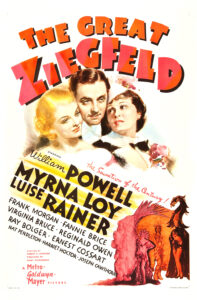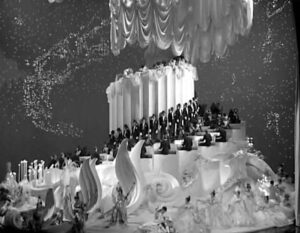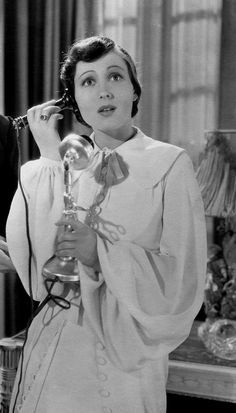The Great Ziegfeld (1936)
 It was the best of times, it was the worst of times—no, not a tale of two cities, but a film that reflects the highs and lows of the era in which it was released. The performances and characterizations are a contradiction of genuine substance and superficial style, of gravity and frivolity, of authenticity and fabrication, and it’s just what audiences wanted to see in 1936. Timing is everything, and The Great Ziegfeld had perfect timing. It was released by MGM during Irving Thalberg’s legendary tenure, right in the middle of the Great Depression, and it served as pure escapism, a blissful antidote to the daily troubles facing our nation.
It was the best of times, it was the worst of times—no, not a tale of two cities, but a film that reflects the highs and lows of the era in which it was released. The performances and characterizations are a contradiction of genuine substance and superficial style, of gravity and frivolity, of authenticity and fabrication, and it’s just what audiences wanted to see in 1936. Timing is everything, and The Great Ziegfeld had perfect timing. It was released by MGM during Irving Thalberg’s legendary tenure, right in the middle of the Great Depression, and it served as pure escapism, a blissful antidote to the daily troubles facing our nation.
The subject of this “biopic” (the first from that genre to win Best Picture) was himself a man who capitalized on the fantasies of others. Florenz Ziegfeld, Jr. “glorified the American girl” with a series of lavish stage productions on Broadway known as the Ziegfeld Follies. Beautiful young women were admired on pedestals or grand staircases, draped in expensive gowns, and worshiped by audiences as the personification of all that was right with the world. This rapturous objectification is of course the ultimate contradiction, elevating attractive ladies to the level of goddesses while eliminating everything human about them. What they think or feel, who they are, is secondary, even irrelevant to how they impress as heavenly decorations. It should be pointed out that Ziegfeld’s objectification was a “deification” and not a reduction. This was no burlesque show or high-class strip club. Still, it is a demeaning, misguided message that beauty, above all else, makes a woman who she is, makes her “important” and powerful, and allows her to reach great heights. But I find everything about this film to be a complex contradiction.
As portrayed by William Powell, Ziegfeld treads rather adeptly around his pursuit of lovely girls. On screen, it’s typically the “girl” of varying ages who makes a pass at him, often in order to win favor with a powerful theatrical producer. If Ziegfeld is ever seen as the pursuer, it’s strictly from a professional vantage. There’s a lot of graceful dancing going on here, and I’m not referring to the chorus. Perhaps it has to do with Billie Burke’s participation. As the widow of Ziegfeld and a former stage star herself, Burke was under contract to MGM and looking to pay off debts mounted by her late husband. She had initially sold the screen rights to Universal in 1933, but that studio found themselves in over their heads with a ballooning budget. In turn, they sold the rights along with some constructed sets and musical arrangements to MGM. Burke agreed to serve as technical advisor and had a firm hand in the script’s development. She saw to it that her beloved late husband was portrayed in a positive light.

“A Pretty Girl Is Like a Melody”
For The Great Ziegfeld, the lavish-factor is dialed up to “extreme.” MGM reportedly spent $220,000 constructing a set for perhaps the most decadent black-and-white musical number ever filmed: “A Pretty Girl Is Like a Melody.” That sum converts to nearly $4 million today … on a single movie set that weighed 100 tons and rotated on a giant turntable. This sequence brings the first act to a close, right before intermission. Road Shows were limited engagements of movies with reserved seats at premium prices that sold in advance of a general, nationwide release. Depending on the length of a film, they would often include an intermission as well as a musical overture, entr’acte, and exit music, all of which are included on the DVD release for this film. At the time of its Oscar win, The Great Ziegfeld had the longest running-time of a Best Picture, clocking in at just over three hours.
The first part of the story involves our protagonist’s climb to success. Ziegfeld is a man with plenty of vision, drive, and ingenuity, but very little pocket money. He manages his ascent by relying on wit, charm, and clever strategy, rather than buying his way to the top. What wealth he does acquire is invested in the next risky venture, and there are plenty of triumphs and setbacks along the way. Early on we are treated to a delightful performance by Frank Morgan as Jack Billings, Ziegfeld’s primary adversary and playful competitor in the field of “entrepreneurial theatrical producer.” Three years after this film, Morgan would enter cinema immortality as the title role in MGM’s The Wizard of Oz. Here, he manages to be an amusing sparring partner for Powell. When the two travel to Europe, they engage in a race to win the attention, affection, and an exclusive contract with Anna Held, played by MGM’s newest rising star Luise Rainer, who would take home the first of her back-to-back Oscars as Best Actress for this performance.

Luise Rainer as Anna Held.
In Rainer, the studio had hoped to groom another Garbo. For Anna Held, Ziegfeld hopes to cultivate another Lillian Russell, an established star of the stage who enthralled audiences and captured their imaginations with a glamorous mystique. Both Rainer (the actress) and Held (the character she plays) seem uncomfortable and out-of-place in their new surroundings. Rainer is a rare screen beauty with saucer eyes, an alluring smile, and high cheekbones. Her performance teeters between temperamental schoolgirl theatrics, intentionally humorous and sweet moments, and genuine dramatic pathos. It’s possible to roll your eyes, laugh at her, and cry with her, all in a matter of moments. Later in the film, she delivers a brief monologue over a telephone, inspired by a Jean Cocteau play called The Human Voice that Rainer had known, when Anna decides to congratulate Ziegfeld on his recent marriage to Billie Burke. She tells him how happy she is while wishing him and his new bride well as the contradicting tears flow from her eyes. It’s the scene that got her the Oscar.
The third major player in this movie is Myrna Loy as Billie Burke. She doesn’t enter the story until well past intermission, but there’s no denying the on-screen chemistry between Powell and Loy. This was their fourth pairing out of fourteen, and they were already box-office gold with The Thin Man series, playing husband-and-wife sleuths Nick and Nora Charles. Aside from lightening her hair (its henna tones lost in black-and-white) and a slight twinkle in her voice, she bares little resemblance to Burke, who had a very distinctive style and screen persona, perhaps never better captured on film than in her iconic turn as Glinda in MGM’s The Wizard of Oz.
As the plot evolves, we meet several stars of the Ziegfeld Follies. Some, like Fanny Brice and dancer Harriet Hoctor, play themselves. Brice, in particular, is given a subplot setup not unlike the one she received decades later in her own bio-musical Funny Girl. She even sings a bit of her signature song “My Man” before the story cuts back to Ziegfeld and his girl troubles. Ray Bolger, yet another connection to MGM’s Oz, plays himself as well, and while Bolger was a big Broadway star at this point, he never actually appeared in the Ziegfeld Follies. Truth is bent even further when real-life stars Marilyn Miller and Lillian Lorraine are fictionalized (to avoid legal action) as Sally Manners, played by an unbilled Rosina Lawrence, and Audrey Dane, who is depicted with world-weary, gin-soaked panache by Virginia Bruce. Early on, Nat Pendleton delivers a memorable turn as true-life, muscle-god Sandow. With his bicep flexes causing a sensation among swooning ladies, he helps establish Ziegfeld as a known theatrical producer. Other lookalikes are introduced for Will Rogers and Eddie Cantor.
Despite countless contradictions between fact and fantasy, The Great Ziegfeld is an epic story of good, old-fashioned, American ingenuity. It inspired audiences during the Great Depression by telling the tale of a man who could make something grand and special out of nothing at all. He had no money and no means, only his talent, his charm, a little cleverness, and his idealized vision of a better life for everyone.
The Great Ziegfeld
| Director | Robert Z. Leonard |
| Primary Cast | William Powell, Myrna Loy, Luise Rainer, Frank Morgan, Fanny Brice, Virginia Bruce, Reginald Owen, Ray Bolger, Ernest Cossart, Nat Pendleton, Harriet Hoctor, Dennis Morgan |
| Familiar Faces | Edwin Maxwell from All Quiet on the Western Front and Grand Hotel |
| Firsts | First biopic to win Best Picture, first performer (Luise Rainer) to win for a musical film |
| Total Wins | 3 (Picture, Actress: Luise Rainer, Dance Direction) |
| Total Nominations | 7 (Picture, Director, Actress: Luise Rainer, Original Screenplay, Dance Direction, Art Direction, Editing) |
| Viewing Format | DVD |

I wondered why Billie Burke did not play herself since Fanny Brice was herself. It made sense when I realized she was his wife. That would have been difficult, for sure.
Of course the costumes and show numbers are outstanding. Their choice of material helps illustrate how much our culture has changed. Quite interesting.
I’m sure there were a number of reasons why Billie Burke either didn’t want to play herself or wasn’t asked (or perhaps both). She was already 51 years old at the time (54 when she played Glinda in “The Wizard of Oz” a few years later), so she may have felt she was too old. Burke was a character actress at MGM, having already appeared in “Dinner at Eight” when she first got there and other major films of the early ’30s. And Myrna Loy was one of the top female stars in Hollywood back then, so I’m sure she was flattered to have Loy play her.
An excellent production. Again, MGM has put forth a great deal of money and created an amazing amount of ‘value’ up there on the screen. And quite a gamble for them to leave it as long as they did. This clearly cut a number of showings out of every day.
Flo is definitely portrayed as quite the ‘angel’ in this picture. Even his clear extramarital affairs are underplayed. Quite a bit of spit and polish on his moral character. You can clearly see Ms. Burke’s hand at work.
Some excellent performances all around. William Powell is his usual charming self. I love Frank Morgan, especially when he chooses not to rely on his ‘bluster’ routine. He’s quite endearing.
Ray Bolger does remarkable work in his solo dance number. I was surprised this never made it into a “That’s Entertainment” film. Great comic flexibility.
About halfway in I found myself wishing the film had be shot in Technicolor. It cries out for it. I also found myself speculating how much, if any, of the actual material or staging from an actual Follies was used or if everything was original. I know some of the songs were.
It also made me long to have witnessed some of these productions first hand. When I think of the remarkable theatres these shows took place in… well, I sat and tried to imagine what it must have been like to be sitting in the house at the Lyric or New Amsterdam or Ziegfeld or The Globe. Or even the roof top at the …Amsterdam. It must have been stunning.
I also thought about what it must have been like to be sitting in the orchestra at The Astor theatre watching this film first run. Back when movies, especially road show films, like this, were an event. Watching some of this on the big screen at The Astor must have been like seeing a production of the Follies themselves.
The film, even on DVD, looks pretty good. Some damage here and there. Hopefully Warners will fix this.
Thanks for weighing in, Michael, and I agree with all of your thoughts. Since the first Technicolor feature film (“Becky Sharp”) had only been released one year earlier, and considering how long “The Great Ziegfeld” took to plan and design, I don’t think Technicolor was considered. These sets are mostly white (like the big Fred & Ginger sets), and costumes in the musical numbers (by Adrian) seem to be either black or white. Switching to color wouldn’t have made much impact without rethinking the art direction and gowns, which very likely wasn’t possible, let alone practical. Speaking of design, this movie has MGM stamped all over it. I doubt any of the numbers reflected the reality of what was done on a Broadway stage, not to mention their sheer size wouldn’t have fit in any New York theatre. They might have taken some inspiration, however. Ray Bolger wasn’t really an MGM star (at least not under long-term contract). He made only a handful of pictures from the mid-1930s through the late 1940s. He was a busy Broadway star and only signed on for one or two-picture deals back then. But I agree, it would have been nice to see him more in the first “That’s Entertainment.” They did include his excised Scarecrow’s dance in Part III.
Soy un fanático de la comedia musical norteameicana y no me canso de ver esta película. Es realmente un espectáculo, máxime teniendo en cuenta que se filmó en 1935/36. Acertado su comentario en cuanto al argumento y los actores. Un saludo desde Mendoza, Argentina.
Wow, hello Ricardo from Mendoza, Argentina! It’s a pleasure to hear from you, and I’m glad you like this movie and my comments about it. I hope the translation into Spanish isn’t too bad. I’m using Google Translate myself to read your post. I look forward to other comments you may have about these Oscar-winning films. We’re lucky to be able to see them today and appreciate what they did so many years ago. Take care, and thank you for posting!